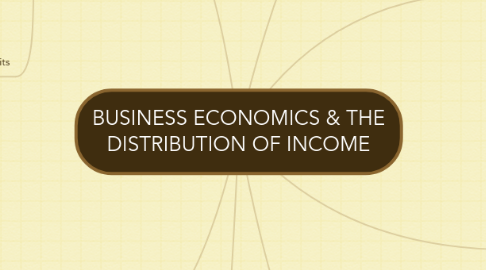
1. Concentrated Markets
1.1. C.R.5= value of output from 5 largest firms / value of output for the industry
1.2. Why do firms grow larger?
1.2.1. Market power motive
1.2.2. Profit Motive
1.2.3. Economies of scale
1.3. How do firms grow larger?
1.3.1. Horizontal intergration
1.3.2. Vertical integration
1.3.3. Lateral merger
1.3.4. Conglomerate merger
2. Price Discrimination
2.1. Conditions
2.1.1. Differences in price elasticity of demand
2.1.2. Barriers to prevent "market seepage"
2.2. Types of price discrimination
2.2.1. First degree
2.2.1.1. Perfect, charging a unique price for each individual unit
2.2.1.2. High cost in finding out how much people are willing to pay
2.2.2. Second degree
2.2.2.1. Selling batches of product at lower prices
2.2.3. Third degree
2.2.3.1. Time
2.2.3.2. Geography
2.2.3.3. Status
3. Monopoly
3.1. Greater than 25% of market share
3.2. Barriers to entry
3.2.1. High fixed cost
3.2.2. Economies of scale
3.2.3. Brand loyalty
3.2.4. Legal barriers
3.2.5. Control over the factors of production
3.2.6. Control over retail outlets
3.2.7. Predatory pricing
3.3. Costs
3.3.1. Abnormal profits
3.3.2. Loss of allocative efficiency
3.3.3. productive and X inefficiency
3.4. Benefits
3.4.1. Lower prices
3.4.2. Potential to reach M.E.S. with natural monopoly
3.4.3. Dynamic efficiency from supernormal profits
3.4.4. Scope to be internationally competitive
4. Costs and Revenues
4.1. Short Run
4.1.1. At least one factor of production is fixed
4.1.2. Cost per unit decreases due to specialisation and dilution of fixed cost
4.1.3. Cost per unit increases due to the law of diminishing marginal return
4.2. Long Run
4.2.1. All factors of production are variable
4.2.2. Cost per unit decreases due to economies of scale
4.2.2.1. Purchasing
4.2.2.2. Administrative
4.2.2.3. Financial
4.2.2.4. Techinal
4.2.3. Cost per unit increases due to diseconomies of scale
4.2.3.1. Control
4.2.3.2. Co-ordiantion
4.2.3.3. Co-operation
5. Profit Maximisation
5.1. Profits are maximized at the point where MC=MR
5.2. The role of profit
5.2.1. Allocation of factors of production
5.2.2. Signal for market entry
5.2.3. Promotes innovation
5.2.4. Investment
5.2.5. Rewards entrepreneurs for bearing risk
5.2.6. Economic performance indicator
6. Perfect Competition
6.1. Market Structures
6.1.1. Perfect Competition
6.1.1.1. Many buyers and sellers
6.1.1.2. No barriers to entry or exit
6.1.1.3. Identical products
6.1.1.4. Perfect information
6.1.1.5. No externalities
6.1.1.6. No economies of scale
6.1.2. Oligopoly
6.1.3. Monopoly
6.2. Factors on which firms compete in imperfectly competitive markets
6.2.1. Brand Advertising
6.2.2. Quality
6.2.3. Differentiation
6.3. Benefits of competition
6.3.1. Lower prices
6.3.2. Greater Entrepreneurial Activities
6.3.3. Economic efficiency
7. Efficiency
7.1. Static
7.1.1. Allocative
7.1.1.1. P=MC
7.1.2. Productive
7.1.2.1. Lowest point of AC curve
7.1.3. X
7.1.3.1. Lying on the AC curve
7.2. Dynamic
7.2.1. Product
7.2.1.1. Innovations
7.2.2. Process
7.2.2.1. Better method of production
